You have to get close to the objects in the Michael Wellby bequest to perceive the astonishing wealth of detail crammed into every glittering square inch. This captivating ship, for example, made out of half a nautilus shell, has tiny golden men swarming its golden rigging, and detachable silver cannons on deck.
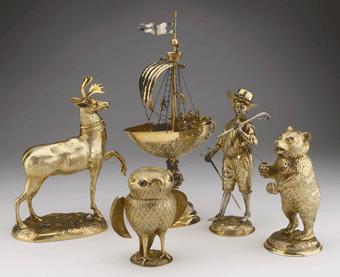
Group of Silver Gilt Figures
© Ashmolean Museum, University of Oxford
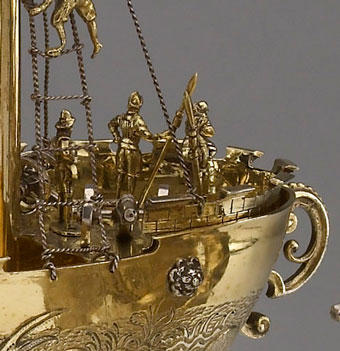
A closer look at the deck of that ship....
© Ashmolean Museum, University of Oxford
The incredible multiplicity of weird creatures hiding in and indeed forming the crevices of this silver-gilt ewer (Portugal, c. 1510) would today have earned their creator a job on the front line at Dreamworks or Studio Ghibli. These pieces are a delight for anyone who ever loved toys or fairy-tales, as well as for those who simply can't resist the shine of precious metals and stones.
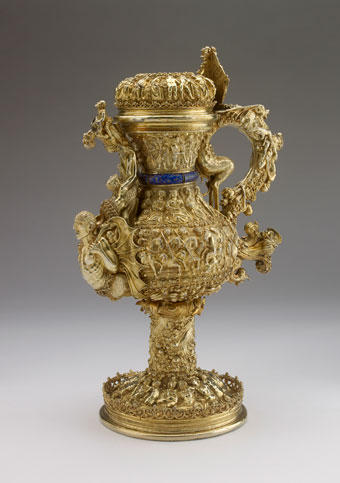
Silver gilt ewer, Portugal (Lisbon?), 1510.
© Ashmolean Museum, University of Oxford
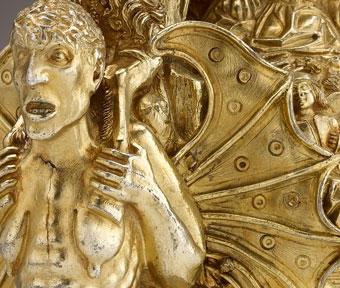
Close up of the ewer. The extraordinary detail of some of the work is staggering.
© Ashmolean Museum, University of Oxford
Click here to open a bigger version in a new window
Daily Info spoke to Timothy Wilson, Keeper of Western Art at the Ashmolean, whose museum has been honoured by what has been described as the most important bequest of this kind of thing to a UK museum in the last 100 years. For Professor Wilson, who first encountered the collection in the romantic setting of "a sort of private treasure chamber" in Michael Wellby's home, the extravagant, flamboyant beauty of these pieces is further enlivened by his sense of their history. "This was the kind of collecting which was done by princes and rulers in central Europe in the Renaissance and Baroque periods. There are still a series of these great Kunstkammers - art and wonder and treasure chambers - in some of the central European capitals in Prague, in Innsbruck, in Vienna and above all in Dresden: a collection called the Green Vault. They are novelty items, show-pieces; wonderfully elaborate, expensive, exotic bling, made with extravagant use of imported materials.
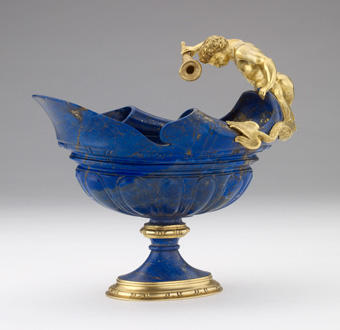
Lapis Lazuli Bowl
Click here to open a bigger version in a new window
© Ashmolean Museum, University of Oxford "For example, this is lapis lazuli which comes from Afghanistan. It's a substantial block with lovely gold veining in it. The carving of the actual stone was done by an Italian of the Miseroni family, in Prague, for the Emperor Rudolf II. Arranged around the top of the lapis lazuli, in gold, is a carved Triton, and he was made by a goldsmith called Paulus van Vianen, who was from Utrecht. So the carver of the stone is coming up from Milan to Prague to work for the Emperor's court and the goldsmith is coming down from Utrecht to make the gold mounts. It is a beautiful illustration of the classic way in which these cultures come together.

Ostrich Egg Cup
© Ashmolean Museum, University of Oxford
"And illustrating that equally well is this cup - it is an ostrich egg which has been mounted in silver gilt, with these lovely delicate floral bits of enamelling and little renaissance motifs of masks and curlicues. And then at the top - just in case you need to be reminded that this is an ostrich egg - there is an extremely proud looking ostrich, and he's holding up a shield of arms which tells us that this was made for the Hapsburg prince of Transylvania (now Roumania), part of the Hapsburg dominions, though at that time (this is dated 1576), under the dominion of the Ottomans."
These objects would have been primarily for show, often to be given as gifts, but they function like the finest of toys should: a silver windmill has tiny perfect revolving sails; the little owl (foreground of the first picture), has wings that flap and his head comes off and acts as a cup like the lid of a thermos flask. A little strolling man has accessories that can be detached - it's astonishing that his slim silver musket is still with him so many centuries after he was made.
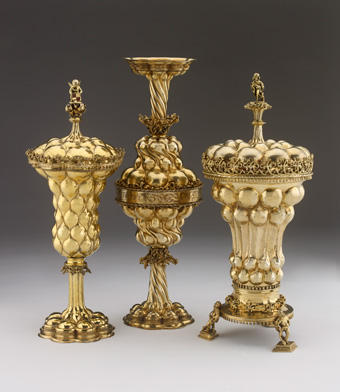
Master Cups from Nuremburg
Click here to open a bigger version in a new window
© Ashmolean Museum, University of Oxford
One of the most eye-catching parts of the bequest is this set of Master Cups, of which three are shown here. These fabulous creations, over a foot tall, are ornate for a very practical reason. Tim explains: "There were two great South German goldsmith centres in the late middle ages and the 16th and 17th centuries: Nuremberg and Augsburg. If you were an apprentice, traditionally the process of coming out of your apprenticeship and becoming a fully fledged master involved making an object which we still call a "masterpiece", meaning particularly an object which demonstrated your command of all the techniques that a goldsmith might be expected to employ: embossing, chasing, casting, piercing, gilding and so on. And the particular form that these masterpiece cups took in Nuremburg, was these very flamboyantly bubbly cups - possibly the bubbles are meant to represent bunches of grapes - and Michael Wellby had a truly remarkable group of these. Certainly these things were the pride and joy of their makers, and I suspect that they probably sometimes stayed with the makers, although sometimes perhaps they had to be given to the guild."
Tim's own favourite piece - "the object, which, if missing, they should come looking for in the Wilson household"- is this "relatively not-over-the-top" ewer and basin, carved of serpentine. The stone, due to strange scaly markings which were taken to represent serpents, "was thought to offer protection against poison and so was particularly valued. The stone was brought to Dresden in about 1580 and carved and set in this lovely silver gilt mount, with this renaissance mer-person and tiny little plaquettes with river gods and so on. It's a lovely balance, it seems to me, of form and decoration."
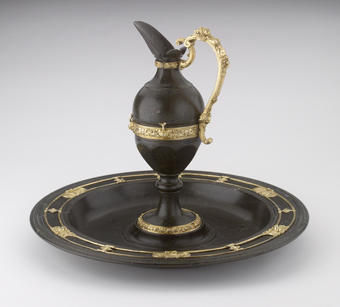
Serpentine and silver gilt ewer and basin.
Click here to open a bigger version in a new window
© Ashmolean Museum, University of Oxford
The collection amounts to some 480 objects, and the Ashmolean is now working on the hefty task of how best to display them. There will be a first display with the theme of "Exotic Objects" from the 19th February in the West Meets East Gallery, but Professor Wilson has hopes of creating a very special display setting for the bulk of the collection. "It will be a matter of planning, and raising money for a proper display, but I do have a space ear-marked for it. Conservation is of course very important, and we need to make sure that we can establish good even humidity. And with objects like these that are of such manifest high value, you have to have very visible security. But also, I would like in some way to recreate the atmosphere of the private room, like the one in which Michael Wellby had them in his house, where I first knew this collection. Because these are such wacky and over-the-top objects I think the display demands some over-the-top theatricality. The great emblem of that of course is the Green Vault, at Dresden. Dresden has the most extraordinary collection anywhere of this kind of thing, formed by the Electors of Saxony in the 16th, 17th and 18th centuries, and that is being redisplayed there substantially in the way it was in the early 18th century: on gilt brackets against great shaped mirrors.
"They got special health and safety permission," he adds rather wistfully, "to blow mirrors in the baroque fashion with mercury backs. I would like to achieve, on a somewhat smaller scale, something of the theatricality of that display, because you know, that seems to be playing to the nature of the objects."



